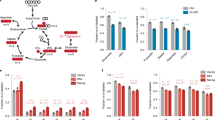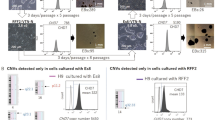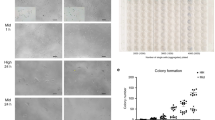Abstract
Measurements of glycolysis and mitochondrial function are required to quantify energy metabolism in a wide variety of cellular contexts. In human pluripotent stem cells (hPSCs) and their differentiated progeny, this analysis can be challenging because of the unique cell properties, growth conditions and expense required to maintain these cell types. Here we provide protocols for analyzing energy metabolism in hPSCs and their early differentiated progenies that are generally applicable to mature cell types as well. Our approach has revealed distinct energy metabolism profiles used by hPSCs, differentiated cells, a variety of cancer cells and Rho-null cells. The protocols measure or estimate glycolysis on the basis of the extracellular acidification rate, and they measure or estimate oxidative phosphorylation on the basis of the oxygen consumption rate. Assays typically require 3 h after overnight sample preparation. Companion methods are also discussed and provided to aid researchers in developing more sophisticated experimental regimens for extended analyses of cellular bioenergetics.
This is a preview of subscription content, access via your institution
Access options
Subscribe to this journal
Receive 12 print issues and online access
$259.00 per year
only $21.58 per issue
Buy this article
- Purchase on Springer Link
- Instant access to full article PDF
Prices may be subject to local taxes which are calculated during checkout








Similar content being viewed by others
References
Glick, B.S. & Pon, L.A. Isolation of highly purified mitochondria from Saccharomyces cerevisiae. Methods Enzymol. 260, 213–223 (1995).
Lemaire, C. & Dujardin, G. Preparation of respiratory chain complexes from Saccharomyces cerevisiae wild-type and mutant mitochondria: activity measurement and subunit composition analysis. Methods Mol. Biol. 432, 65–81 (2008).
Frezza, C., Cipolat, S. & Scorrano, L. Organelle isolation: functional mitochondria from mouse liver, muscle and cultured fibroblasts. Nat. Protoc. 2, 287–295 (2007).
Kuznetsov, A.V. et al. Analysis of mitochondrial function in situ in permeabilized muscle fibers, tissues and cells. Nat. Protoc. 3, 965–976 (2008).
Thomson, J.A. et al. Embryonic stem cell lines derived from human blastocysts. Science 282, 1145–1147 (1998).
Takahashi, K. et al. Induction of pluripotent stem cells from adult human fibroblasts by defined factors. Cell 131, 861–872 (2007).
Park, I.H. et al. Disease-specific induced pluripotent stem cells. Cell 134, 877–886 (2008).
Lowry, W.E. et al. Generation of human induced pluripotent stem cells from dermal fibroblasts. Proc. Natl. Acad. Sci. USA 105, 2883–2888 (2008).
Yu, J. et al. Induced pluripotent stem cell lines derived from human somatic cells. Science 318, 1917–1920 (2007).
Wang, Y. et al. Embryonic stem cell-specific microRNAs regulate the G1-S transition and promote rapid proliferation. Nat. Genet. 40, 1478–1483 (2008).
Becker, K.A. et al. Self-renewal of human embryonic stem cells is supported by a shortened G1 cell cycle phase. J. Cell Physiol. 209, 883–893 (2006).
Murry, C.E. & Keller, G. Differentiation of embryonic stem cells to clinically relevant populations: lessons from embryonic development. Cell 132, 661–680 (2008).
Chung, S. et al. Mitochondrial oxidative metabolism is required for the cardiac differentiation of stem cells. Nat. Clin. Pract. Cardiovasc. Med. 4 (suppl. 1): S60–S67 (2007).
Zhang, J. et al. UCP2 regulates energy metabolism and differentiation potential of human pluripotent stem cells. EMBO J. 30, 4860–4873 (2011).
Folmes, C.D. et al. Somatic oxidative bioenergetics transitions into pluripotency-dependent glycolysis to facilitate nuclear reprogramming. Cell Metab. 14, 264–271 (2011).
Prigione, A., Fauler, B., Lurz, R., Lehrach, H. & Adjaye, J. The senescence-related mitochondrial/oxidative stress pathway is repressed in human induced pluripotent stem cells. Stem Cells 28, 721–733 (2010).
Hatefi, Y. The mitochondrial electron transport and oxidative phosphorylation system. Annu. Rev. Biochem. 54, 1015–1069 (1985).
Warburg, O. Uber den Stoffwechsel der Carcinomzelle. Klin Wochenschr 4, 534–536 (1925).
Warburg, O. On the origin of cancer cells. Science 123, 309–314 (1956).
Simsek, T. et al. The distinct metabolic profile of hematopoietic stem cells reflects their location in a hypoxic niche. Cell Stem Cell 7, 380–390 (2010).
Takubo, K. et al. Regulation of the HIF-1 alpha level is essential for hematopoietic stem cells. Cell Stem Cell 7, 391–402 (2010).
Watanabe, K. et al. A ROCK inhibitor permits survival of dissociated human embryonic stem cells. Nat. Biotechnol. 25, 681–686 (2007).
Comte, J., Maisterrena, B. & Gautheron, D.C. Lipid composition and protein profiles of outer and inner membranes from pig heart mitochondria. Comparison with microsomes. Biochim. Biophys. Acta 419, 271–284 (1976).
Matlib, M.A., Shannon, W.A. Jr . & Srere, P.A. Measurement of matrix enzyme activity in situ in isolated mitochondria made permeable with toluene. Methods Enzymol. 56, 544–550 (1979).
Milner, D.J., Mavroidis, M., Weisleder, N. & Capetanaki, Y. Desmin cytoskeleton linked to muscle mitochondrial distribution and respiratory function. J. Cell Biol. 150, 1283–1298 (2000).
Wieckowski, M.R., Giorgi, C., Lebiedzinska, M., Duszynski, J. & Pinton, P. Isolation of mitochondria-associated membranes and mitochondria from animal tissues and cells. Nat. Protoc. 4, 1582–1590 (2009).
Wittig, I., Braun, H.P. & Schagger, H. Blue native PAGE. Nat. Protoc. 1, 418–428 (2006).
Rolo, A.P., Palmeira, C.M. & Cortopassi, G.A. Biosensor plates detect mitochondrial physiological regulators and mutations in vivo. Anal. Biochem. 385, 176–178 (2009).
McConnell, H.M. et al. The cytosensor microphysiometer: biological applications of silicon technology. Science 257, 1906–1912 (1992).
Severinghaus, J.W. & Astrup, P.B. History of blood gas analysis. IV. Leland Clark's oxygen electrode. J. Clin. Monit. 2, 125–139 (1986).
Silva, A.M. & Oliveira, P.J. Evaluation of respiration with Clark-type electrode in isolated mitochondria and permeabilized animal cells. Methods Mol. Biol. 810, 7–24 (2012).
Gohil, V.M. et al. Nutrient-sensitized screening for drugs that shift energy metabolism from mitochondrial respiration to glycolysis. Nat. Biotechnol. 28, 249–255 (2010).
Xie, H. et al. LDH-A inhibition, a therapeutic strategy for treatment of hereditary leiomyomatosis and renal cell cancer. Mol. Cancer Ther. 8, 626–635 (2009).
Delgado, T. et al. Induction of the Warburg effect by Kaposi's sarcoma herpesvirus is required for the maintenance of latently infected endothelial cells. Proc. Natl. Acad. Sci. USA 107, 10696–10701 (2010).
Sanchez Cenizo, L. et al. Up-regulation of the ATPase inhibitory factor 1 (IF1) of the mitochondrial H+-ATP synthase in human tumors mediates the metabolic shift of cancer cells to a Warburg phenotype. J. Biol. Chem. 285, 25308–25313 (2010).
de Groof, A.J. et al. Increased OXPHOS activity precedes rise in glycolytic rate in H-RasV12/E1A transformed fibroblasts that develop a Warburg phenotype. Mol. Cancer 8, 54 (2009).
Ray, L.B. Metabolism is not boring. Science 330, 1337 (2010).
Zhang, J., Khvorostov, I. & Teitell, M. From MEFs to matrigel I: passaging hESCs in the presence of MEFs. J. Vis. Exp. 16, pii: 722 (2008).
Khvorostov, I., Zhang, J. & Teitell, M. From MEFs to Matrigel 2: splitting hESCs from MEFs onto Matrigel. J. Vis. Exp. 16, pii: 831 (2008).
Zhang, J., Khvorostov, I. & Teitell, M. From MEFs to Matrigel 3: passaging hESCs from Matrigel onto Matrigel. J. Vis. Exp. 16, pii: 832 (2008).
Gurumurthy, S. et al. The Lkb1 metabolic sensor maintains haematopoietic stem cell survival. Nature 468, 659–663 (2010).
Kimmelman, A.C. The dynamic nature of autophagy in cancer. Genes Dev. 25, 1999–2010 (2011).
Zaugg, K. et al. Carnitine palmitoyltransferase 1C promotes cell survival and tumor growth under conditions of metabolic stress. Genes Dev. 25, 1041–1051 (2011).
Warburg, O. On respiratory impairment in cancer cells. Science 124, 269–270 (1956).
DeBerardinis, R.J., Lum, J.J., Hatzivassiliou, G. & Thompson, C.B. The biology of cancer: metabolic reprogramming fuels cell growth and proliferation. Cell Metab. 7, 11–20 (2008).
Moreno-Sanchez, R., Rodriguez-Enriquez, S., Marin-Hernandez, A. & Saavedra, E. Energy metabolism in tumor cells. FEBS J. 274, 1393–1418 (2007).
Clark, L.C. Jr . Kaplan, S., Matthews, E.C., Edwards, F.K. & Helmsworth, J.A. Monitor and control of blood oxygen tension and pH during total body perfusion. J. Thorac. Surg. 36, 488–496 (1958).
Clark, L.C.J. Monitor and control of blood and tissue oxygen tension. Trans. Am. Soc. Artif. Internal Organs 2, 41–49 (1956).
Pesta, D. & Gnaiger, E. High-resolution respirometry: OXPHOS protocols for human cells and permeabilized fibers from small biopsies of human muscle. Methods Mol. Biol. 810, 25–58 (2012).
Wu, M. et al. Multiparameter metabolic analysis reveals a close link between attenuated mitochondrial bioenergetic function and enhanced glycolysis dependency in human tumor cells. Am. J. Physiol. Cell Physiol. 292, C125–C136 (2007).
Weegman, B.P. et al. Continuous real-time viability assessment of kidneys based on oxygen consumption. Transplant. Proc. 42, 2020–2023 (2010).
Crouch, S.P., Kozlowski, R., Slater, K.J. & Fletcher, J. The use of ATP bioluminescence as a measure of cell proliferation and cytotoxicity. J. Immunolog. Methods 160, 81–88 (1993).
Scaduto, R.C. Jr . & Grotyohann, L.W. Measurement of mitochondrial membrane potential using fluorescent rhodamine derivatives. Biophys. J. 76, 469–477 (1999).
Lee, W.N., Wahjudi, P.N., Xu, J. & Go, V.L. Tracer-based metabolomics: concepts and practices. Clin. Biochem. 43, 1269–1277 (2010).
Gerencser, A.A. et al. Quantitative microplate-based respirometry with correction for oxygen diffusion. Anal. Chem. 81, 6868–6878 (2009).
Acknowledgements
We thank J. Tang for hESCs. Supported by CIRM grants RS1-00313, RB1-01397, TB1-01183, TG2-01169, a training grant from the Broad Stem Cell Research Center at the University of California Los Angeles, and US National Institutes of Health grants GM061721, GM073981, PNEY018228, P01GM081621, CA156674 and CA90571. C.M.K. is an Established Investigator of the American Heart Association and M.A.T. was a Scholar of the Leukemia and Lymphoma Society. We thank D. Wallace (University of Pennsylvania) for Rho0 143B TK− human osteosarcoma cells.
Author information
Authors and Affiliations
Contributions
J.Z.: conception and design, collection and assembly of data, data analysis and interpretation, manuscript writing; E.N.: conception and design, data collection and analysis, manuscript writing; D.R.R.W.: collection and assembly of data, data analysis and interpretation; K.S., J.S.H., C.M.V.H., S.S.I., L.V.: technical support and assistance; C.S.M.: conception and design, data analysis and interpretation, manuscript writing; C.M.K.: conception and design, data analysis and interpretation, manuscript writing; M.A.T.: conception and design, data analysis and interpretation, manuscript writing, final approval of the manuscript and financial support.
Corresponding author
Ethics declarations
Competing interests
The authors declare no competing financial interests.
Supplementary information
Supplementary Fig. 1
Overview of assessed metabolic pathways. Glucose enters into the glycolytic pathway (orange panel). Pyruvate, a cytosolic product of glycolysis, can be converted into lactate, which can be excreted from cells using monocarboxylate transporters in the plasma membrane. Assessment of the extracellular acidification rate (ECAR) using the XF24 Extracellular Flux Analyzer (indicated by a seahorse icon; Seahorse Bioscience) is a good approximation of lactate excretion under most circumstances. Pyruvate can also be converted into two molecules of acetyl-CoA, which can enter the citric acid cycle (blue circle) within the mitochondrial matrix. The citric acid cycle generates energy equivalents that feed the electron transport chain for cell respiration (green panel). The activity of individual electron transport chain complexes (CI – IV and CV, the ATP synthase) can be assessed using specific inhibitors (indicated next to the complexes they inhibit) by measuring oxygen consumption with either the XF24 analyzer or a Clark-type oxygen electrode. The glycerol-3-phosphate-cycle (purple panel) links the glycolytic pathway, through the intermediate dihydroxyacetone-phosphate, to the electron transport chain. The flavoprotein-dehydrogenase (FP-dehydrogenase) transfers electrons from glycerol-3-phosphate to FAD to generate FADH2 that subsequently passes electrons from ubiquinone (Q) to ubiquinol (QH2). Finally, QH2 supplies electrons to the electron transport chain (see glycerol-3-phosphate as a substrate in Table 3). (TIFF 2070 kb)
Supplementary Fig. 2
OCR/ECAR ratios for normal human dermal fibroblast (NHDF) cells grown with or without 10 µM ROCK inhibitor (RI). Error bars represent the mean ± SD (n = 3). Figure is reprinted with permission from ref 14. (TIFF 547 kb)
Rights and permissions
About this article
Cite this article
Zhang, J., Nuebel, E., Wisidagama, D. et al. Measuring energy metabolism in cultured cells, including human pluripotent stem cells and differentiated cells. Nat Protoc 7, 1068–1085 (2012). https://doi.org/10.1038/nprot.2012.048
Published:
Issue Date:
DOI: https://doi.org/10.1038/nprot.2012.048
This article is cited by
-
Optimization of differential filtration-based mitochondrial isolation for mitochondrial transplant to cerebral organoids
Stem Cell Research & Therapy (2023)
-
Aerobic glycolysis is the predominant means of glucose metabolism in neuronal somata, which protects against oxidative damage
Nature Neuroscience (2023)
-
The role of pyruvate-induced enhancement of oxygen metabolism in extracellular purinergic signaling in the post-cardiac arrest rat model
Purinergic Signalling (2023)
-
lncRNA miR4458HG modulates hepatocellular carcinoma progression by activating m6A-dependent glycolysis and promoting the polarization of tumor-associated macrophages
Cellular and Molecular Life Sciences (2023)
-
Glutamine addiction promotes glucose oxidation in triple-negative breast cancer
Oncogene (2022)
Comments
By submitting a comment you agree to abide by our Terms and Community Guidelines. If you find something abusive or that does not comply with our terms or guidelines please flag it as inappropriate.



